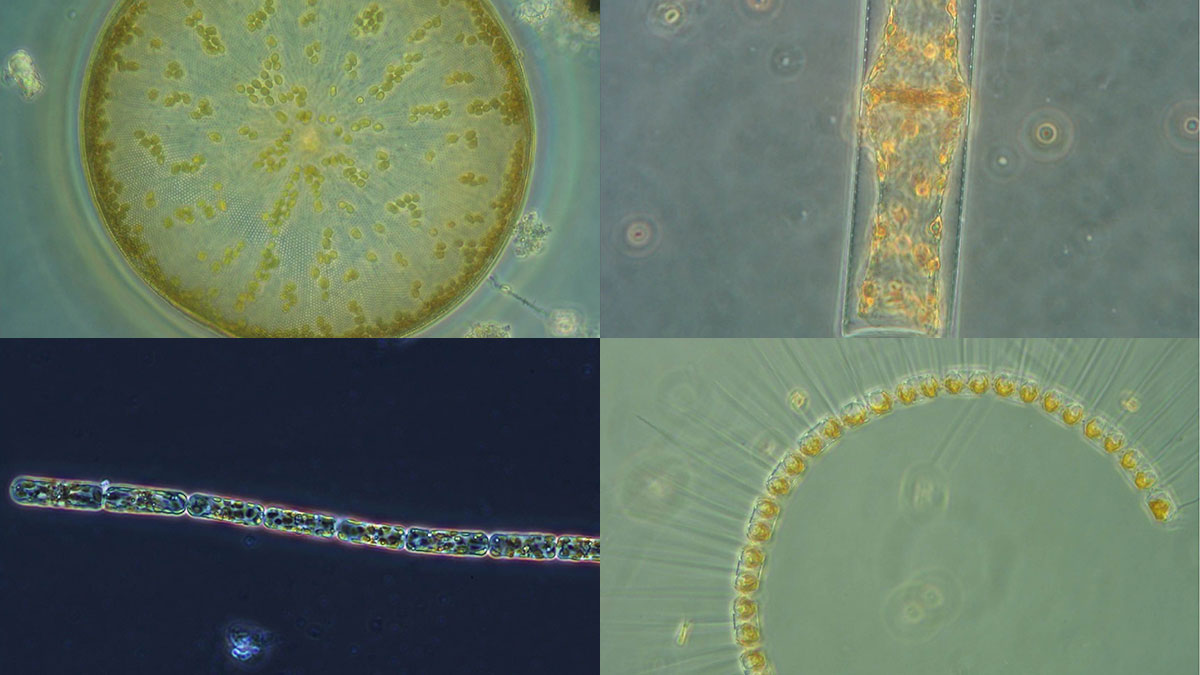Diatoms are a type of single-celled alga invisible to the naked eye. Their opal shells are built with silicic acid, a dissolved form of silica. Like other algae, diatoms need light to survive and favor the sunlight zone of surface waters before dissolving and sinking to the seafloor.
As the most dominant primary producers in marine food webs, diatoms convert carbon dioxide (CO2), water, and light into food and oxygen for other organisms. Diatoms generate around 20% of Earth’s oxygen and transport CO2 to the deep ocean for long-term storage.
Being sensitive to their surroundings, diatoms can reveal clues about environmental change. Scientists analyze living diatoms to understand current trends and fossil diatoms to unravel events from millions of years ago, as geological evidence has shown that diatoms date back to at least the Lower Cretaceous.
The Current Threat of Climate Change
Climate change has many effects on aquatic environments, including ocean acidification (OA), the process of seawater pH decreasing (acidifying) due to a greater uptake of CO2 from the atmosphere. This acidification affects the survival of marine life, resulting in such phenomena as coral bleaching, declining oyster reproduction, altered clam metabolism, and compromised immune responses in sea urchins. The food webs associated with these organisms are not always able to adjust to swift population declines.
Ecological collapses associated with ocean acidification have occurred before. During the Paleocene-Eocene Thermal Maximum (PETM) about 55.8 million years ago, for example, coral reefs disappeared, and deep-sea microbes nearly disappeared in an extinction event associated with ocean acidification. Geologists look back at these times to understand what is happening now. Alarmingly, research has shown that CO2 levels are rising even faster today than they did during the PETM.
Diatoms Are Not Immune
Diatoms have usually been considered less vulnerable to OA compared with calcifying organisms like corals, but they are not entirely immune, recent research has suggested. In a study published in Nature, Jan Taucher of the GEOMAR Helmholtz Centre for Ocean Research Kiel and his coresearchers completed experiments, a meta-analysis, and Earth system model simulations to predict how OA could globally affect diatoms in the future.
They conducted five in situ mesocosm experiments (involving a kind of oversized “test tube”) with natural plankton communities in different biomes, finding that OA would increase the elemental ratio of silicon (Si) to nitrogen (N). This shift appeared to be caused by the slower dissolution of silica as seawater pH decreases, a theory supported by the researchers’ analysis of global sediment trap data.

Taucher explained that the slower dissolution of diatoms’ opal shells limits the abundance and distribution of the microbes: “These shells sink deeper before being converted back to dissolved Si. This leads to a redistribution of Si, i.e., less silicic acid in the surface ocean…meaning that less of this nutrient remains in the surface ocean,” which is where diatoms can access the sunlight they need to survive.
“Given how diatoms play critical roles in marine food webs and Earth’s carbon cycle, a decline in diatoms in the world’s oceans could have substantial consequences.”
Adrian Marchetti, an associate professor in the University of North Carolina at Chapel Hill’s Department of Earth, Marine, and Environmental sciences, said that “the study provides new insights into how OA will alter the remineralization of silica in the ocean.”
“Given how diatoms play critical roles in marine food webs and Earth’s carbon cycle,” he said, “a decline in diatoms in the world’s oceans could have substantial consequences.”
Taucher and his coauthors projected that OA will drive a global decline of diatoms by between 13% and 26% by the year 2200.
—Clarissa Wright (@ClarissaWrights), Science Writer

